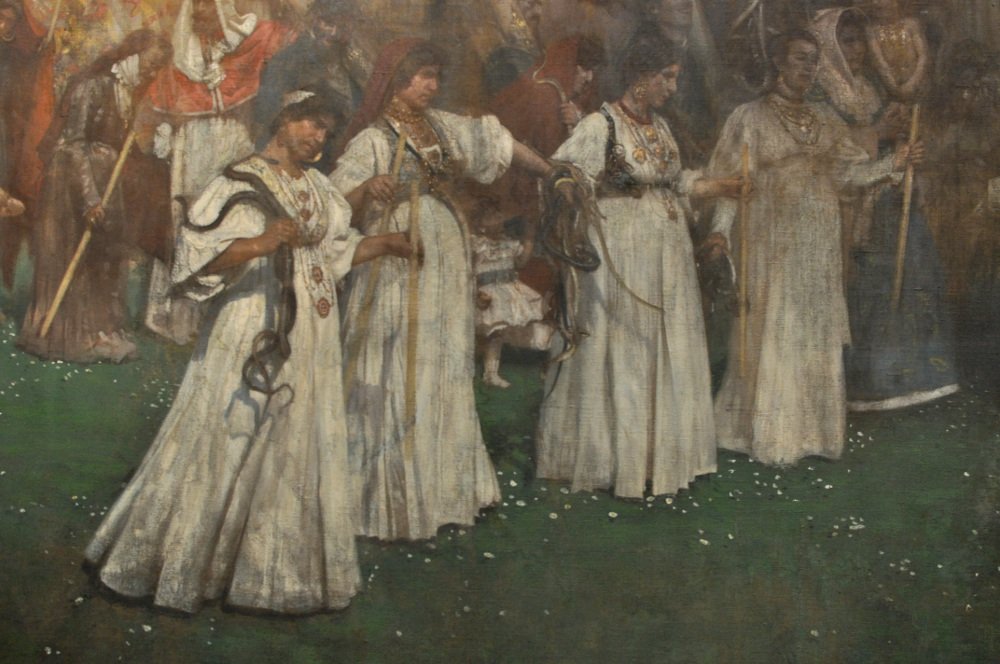Angitia's Medicine Chest
Cocullo, 1951, I Serpari, David Seymour
Angitia is a Mountain Herbalist from Abruzzo in pre-roman times. Her people were the plants, the subjugated, those on the periphery. Her spirit resides with medicinal plants and snakes in the mountains. Not widely known, like a lot of the real ones, and often billed merely as a snake charmer by those who have heard of her. But her communion with snakes was more so indicative of her larger relationship and work with the Earth. Angitia was one with the Apennines and the abundance of diverse life forms that called these mountains home. She had deep relationships with the wildlife in order to understand their ecological place, habits, preferences—to best live in a rhythm with them. She dedicated her life to learning from the plants, listening to their much needed messages for people, and passing them on. It can sound romantic, and sometimes it is, but it’s also often thankless work—sacrifice. We love the image of the witch helping her community, but also love to forget how the witches were hunted, turned on by those communities.
The stories the Nonne keep and share about Angitia make sure not to paint over these truths. One of my favorite stories my bisnonna Zuzu told me was about Angitia’s medicine chest. I love the way Zuzu told stories, really calm and matter of fact. She would tell me that Angitia was a doctor before there were doctors. Helping people get better from whatever ailed them. But she didn’t do it by divine force, insisting she herself was not a healer, but a force of nature. She was an outsider from the larger community, operating within a small circle of people who also lived on the periphery. The people of the larger community would judge and ridicule her but would also seek out her assistance.
When they fell ill and sought out her help, she would bring them to her medicine chest. There she kept a simple array of local plant friends that she tended and harvested for medicine. She instructed the people to choose the plants they were drawn to, but to understand that if they accepted the medicine the plant has to offer, that they would have to offer the plant something back. If they agreed Angitia would make them medicine of the plant they chose for them to take until they got better. While they were healing Angitia would tell them stories of how she met and got to know the plant they bonded with and chose. When the person felt well again she instructed them to go to the plant where it grew in the wild and to do whatever the plant asked of them next.
detail from Le Serpi, 1900, Francesco Paolo Michetti—depicting Festa dei Serpari which takes place in the beginning of May each year in Cocullo, Abruzzo. Though Saint Domenico is the featured honoree today, originally this festa honored Angitia.
Angitia would so often be delighted in running into each of these people later on, to find them spending time with the plants, taking care of them, and showing up in the world in much different ways than they previously had—free, empowered, connected—feeling a sense of purpose and responsibility to the Earth. Zuzu would always end with, “and now they call her a snake charmer, ha! See why it is important to tell your own story, and also to encourage others to tell theirs.” This story always struck a chord with me. As a young, spirited kid maybe it was just a good story about a witch that did it for me. But as I’ve grown up and continued to deepen my relationships in the world, it continues to feel more and more important—to live out our lives not as individual pursuits but as ecological ones, even and especially when its hard—and to tell our own stories—stories rooted in our lived experiences and collective truths rather than the oft repeated hero’s journey. Too many stories get buried in time, or purposely diluted to obscure their message, here’s to digging them up and sharing them freely.

